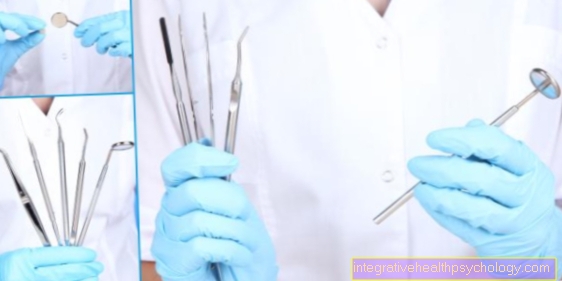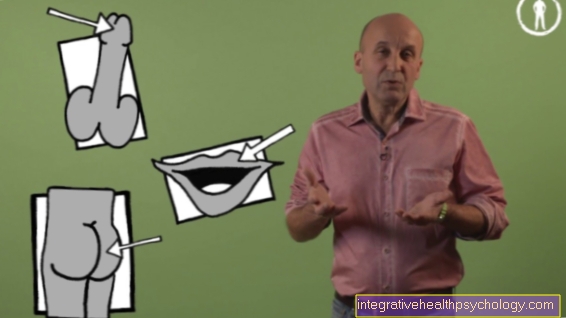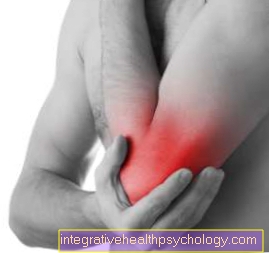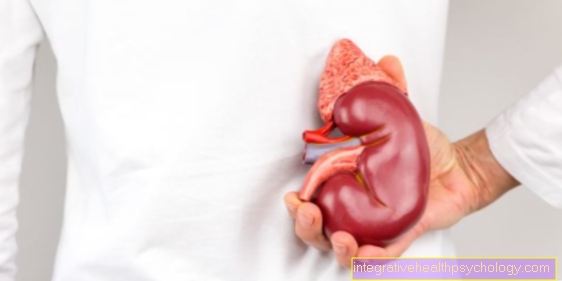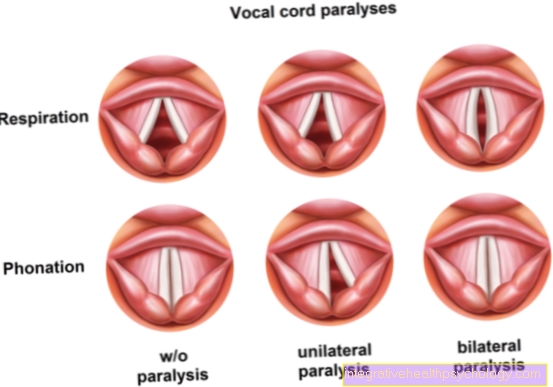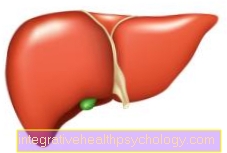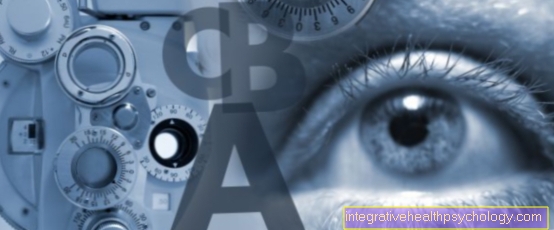Symptoms of aortic dissection
introduction
In medicine, the term aortic dissection refers to the splitting of the wall layers of the main artery (aorta). This split occurs most often through tears in the inner vessel wall, which leads to bleeding into the individual wall layers of the main artery. In most cases, this causes severe, sudden pain and, if the main artery ruptures, it can lead to a life-threatening situation with circulatory disorders and massive internal blood loss.

Symptoms of aortic dissection
The following signs are typical of an aortic dissection
-
Leading symptom: sudden onset, violent pain - usually tearing or stabbing
-
shortness of breath
-
Chest pain
-
Pain in the arms or legs (depending on the location of the dissection)
-
stomach pain
-
Drop in blood pressure
-
Loss of consciousness
-
dizziness
-
Pulse acceleration
-
difficulties swallowing
Pain as a symptom
Chest or abdominal pain is the main symptom of aortic dissection. As a rule, these set in suddenly and are of a sharp pain. Most patients experience the pain in maximum intensity, "never experienced pain", not infrequently with accompanying symptoms of anxiety, curvature of pain and even unconsciousness.
A wandering of the pain from the chest area down into abdominal, flank and leg pain is also often described. In addition to chest pain, depending on the location of the aortic dissection, pain in the back or between the shoulder blades can also set in. A silent aortic dissection is also possible; this is accompanied by no pain or other symptoms and is usually only noticeable during routine examinations.
Shortness of breath as a symptom
In addition to sudden, sharp pain in the chest or back, shortness of breath is one of the most common symptoms associated with an aortic dissection. In combination with the pain, this is felt by most patients to be very restrictive and often leads to a strong feeling of fear and panic attacks.
Complications of aortic dissection
Kidney failure
Acute kidney failure is also a not uncommon complication of aortic dissection, as the vessels supplying the kidneys branch off directly from the main artery. If the aorta ruptures at this level or above, the arterial supply is no longer sufficient for adequate blood flow to the kidneys. The result is a functional impairment with reduced or even no more urine excretion (you can no longer urinate in the toilet), which leads to a build-up of excretable, sometimes toxic substances in the body's circulation.
shock
In medicine, the term shock is a life-threatening clinical picture based on a circulatory disorder. In the course of the aortic dissection, a so-called volume deficiency shock can occur, which is caused by the great loss of blood. There is a disproportion between the volume that is ejected by the heart per minute and the required blood flow to the organs. Signs of shock include blisters, cold sweats, loss of blood pressure, rapid and shallow breathing, and even collapse.
Further information on this topic can be found at: shock
stroke
A dreaded complication of aortic dissection is a stroke caused by the shearing of the arteries supplying the head, such as the Common carotid artery (carotid artery). How the stroke is then noticeable depends on the one hand on the individual and on the other on the location of the dissection. Symptoms can progress slowly but usually come on suddenly. The severity of the symptoms is determined by the brain area that was not supplied with enough oxygen.
The most common signs of a stroke are listed below:
-
sudden very severe headache
-
Sudden problems speaking, slurred speech, choppy speech or even loss of speech
-
sudden disturbance of consciousness up to loss of consciousness
-
Sudden unilateral symptoms of paralysis, which are noticeable in the immobility of an arm, leg or a drooping eyelid or corner of the mouth
-
unilateral numbness, tingling sensation in one half of the body
-
Difficulty and insecurity when walking due to dizziness or swaying, risk of falling
-
Sudden visual disturbances, eye flickering, double vision and even blindness
The symptoms of a stroke are very typical and can be provisionally recorded with the FAST test. This makes it possible to detect the stroke early, which in turn is an important prognostic factor. The “FAST” stands for F-Face, A-Arms, S-Speech, T-Time.
Ask the person concerned to smile and pay attention to the two corners of the mouth. During a stroke, the affected corner of the mouth hangs down due to hemiplegia of the face. When examining the arms, ask the person to raise both arms to the same height, looking for possible signs of paralysis. To check the language, ask the person to repeat sentences. The “time” factor is the most important aspect. Even if a stroke is slightly suspected, the doctor should be alerted as soon as possible.
For more information, see: Blood clots in the head
Paraplegia
Paraplegia is a rather rare, but all the more serious complication of aortic dissection. The bleeding into the tear in the aortic wall or the abdominal cavity can lead to an insufficient supply of the spinal cord and motor nerves, which leads to paralysis. The symptoms of paralysis can be reversed with rapid therapy and ensuring the blood circulation. Again, time is the decisive factor.
For more information, see: Paraplegia
Risk factors for aortic dissection
Since aortic dissection is an acute onset and life-threatening clinical picture, there are no preceding warning signs. However, there are risk factors that favor aortic dissection. The most important ones include high blood pressure, fat deposits in the main artery (arteriosclerosis) and hereditary diseases - e.g. Marfan syndrome, Ehlers-Danlos syndrome, vasculitis. In the presence of one or more of these underlying diseases and acute occurrences such as chest pain, shortness of breath, blood pressure crises or paralysis, an aortic dissection should be considered as the cause and a doctor should be consulted immediately or the emergency services should be alerted.
For more information, see:
- Marfan's Syndrome
- Ehlers-Danlos Syndrome
The different types of aortic dissection
Depending on the location of the aortic dissection, a distinction is made between two types: Aortic dissection type A and B. Type A is a dissection of the vessel wall in the ascending part of the main artery and type B is a dissection in the descending part further away from the heart.
Particularly with type A aortic dissection, very quick identification and action is necessary due to the proximity to the heart and the arteries supplying the head. Specific complications of type A aortic dissection are myocardial infarction with sudden onset of stabbing pain or a feeling of pressure behind the sternum, possibly radiating into the left shoulder and jaw. Often there are shortness of breath and palpitations, sudden headaches and associated neurological symptoms of loss, such as speech or gait disorders or paralysis.
Read more on the subject below: Aortic dissection type A
In type B aortic dissection, the entire descending main artery can be affected, right up to the branching into the arteries supplying the legs. For this reason, symptoms such as acute abdominal pain due to insufficient supply of the intestine, acute kidney failure and paraplegia are in the foreground in type B dissection.
However, a combination of symptoms can also occur in which both the ascending part of the main artery and the descending part are affected.







